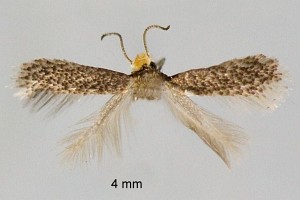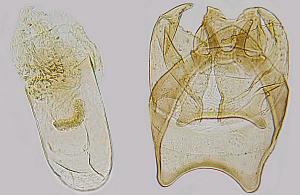

 +17Kontinente:EUAS
+17Kontinente:EUAS2. Diagnose
2.1. Männchen
2.2. Genitalien
2.2.1. Männchen
3. Biologie
3.1. Nahrung der Raupe
[Bladmineerders.nl] warnt: "It is hardly posasible [possible] to distinguish the mines from those of Stigmella anomalella and St. centifoliella." Als Nahrungspflanzen aufgelistet werden:
- [Rosaceae:] Rosa pimpinellifolia (Bibernell-Rose, Dünen-Rose)
- [Rosaceae:] Rosa rugosa (Kartoffel-Rose)
- [Rosaceae:] Rosa sp. (Rose)
- [Rosaceae:] Sanguisorba minor (Kleiner Wiesenknopf)
(Autor: Erwin Rennwald)
4. Weitere Informationen
4.1. Etymologie (Namenserklärung)
Van Nieukerken (1990: 241) kommentiert "A noun in genitive singular. Named in honour of my friend Roland Johansson, specialist of Nepticulidae, and outstanding painter of these moths."
Die Autoren der Erstbeschreibung (Nel & Varenne & 2013) des Synonyms Stigmella cyrneorolandi erläutern ihre Namenswahl: "« cyrneorolandi », juxtaposition de « cyrneo » pour l'origine géographique (Corse) et de « rolandi » pour ses affinités avec. S. rolandi, espèce dédié à Roland Johansson par Nieukerken".
4.2. Synonyme
- Stigmella cyrneorolandi Nel & Varenne, 2013 [synonymisiert durch Huemer & van Nieukerken (2021)]
4.3. Taxonomie
Die Autoren der Stigmella cyrneorolandi stellen ihre von Korsika beschriebene Art in die Gruppe um Stigmella sanguisorbae, zu der auch Stigmella rolandi gehört. Ihre Beschreibung fußt auf einem einzigen Männchen. Die Wahrscheinlichkeit, dass es sich hier um ein Synonym von Stigmella rolandi handelte, war von vorneherein sehr hoch. Die Synonymisierung durch Huemer & van Nieukerken (2021: 303-304) kam also wenig überraschend: "Stigmella cyrneorolandi was described from a male holotype and compared with Stigmella rolandi and other species in the S. sanguisorbae group. We obtained a short sequence of 307 bp that is more than 99% similar to most specimens of S. rolandi, that all fall in the same BIN. The described difference is mainly in the tip of the valvae, that may be either damaged or deformed in the Corsican specimen (we did not study the slide). The description did not mention the important character of male S. rolandi, the very long hairpencil on the hindwing and the associated groove in the forewing underside scaling (van Nieukerken 1990), but the upperside photo just shows some of the long hairs extending beyond the right forewing. We consider S. cyrneorolandi as synonym of S. rolandi. This species is widespread in the southern half of Europe from Spain eastwards to west Siberia. It also occurs on Sardinia."
4.4. Faunistik
Nach Gaedike & Heinicke (1999) kommt die Art in Deutschland vor. Quelle der Meldung war der Fund eines Falters am 1. Juli 1998 bei Klotten an der Mosel, über den Biesenbaum (1999) berichtet. In jener Arbeit gibt es auch eine gesamteuropäische Verbreitungskarte zur Art (u.a. mit 2 Punkten in Niederösterreich). Klotten an der Mosel ist dabei der bei weitem nördlichste bisherige Fundpunkt der trockenwarme Biotope besiedelnden Art.
Nach SwissLepTeam (2010) ist die Art auch Faunenbestandteil der Schweiz (Wallis (ohne Simplon-Südseite)): Basis der Meldung ist ein männlicher Falter, den A. Kopp am 28. Juli 2008 bei Leuk VS sammelte.
Rákosy & Goia (2021: 172) melden zu Rumänien: "Two specimens were collected by A. Laštůvka, in 1997, near Turnu Severin. (Pers. comm. E. J. van Nieukerken, 2006). There is a recent report of this species from Trascău Mountains, the Turda Gorges (Unpublished data: leg. & coll. C. Wieser 2015)."
(Autor: Erwin Rennwald)
4.5. Typenmaterial
Nel & Varenne (2013) teilen zum Synonym Stigmella cyrneorolandi mit:
"Holotype mâle : Bravone, Linguizzetta, Corse du Sud, 2 m, 6-X-2012, uv, Th. Varenne leg., prép. gen. TV n° 5215, collection Th. Varenne à Nice."
4.6. Literatur
- Biesenbaum, W. (1999): Stigmella rolandi van Nieukerken, 1990 als Neufund für die Bundesrepublik Deutschland (Lep., Nepticulidae). — Melanargia 11 (2): 127-128. [PDF auf ag-rh-w-lepidopterologen.de, ganzes Heft]
- Huemer, P. & E. van Nieukerken (2021): Identity of some recently described Lepidoptera from France — re-assessed with DNA barcodes and morphology. — Zootaxa 4941 (3): 301–337. [zum open-access-Artikel und PDF-download auf mapress.com]
- Beschreibung als Stigmella cyrneorolandi: Nel, J. & T. Varenne (2013): Description de Stigmella cyrneorolandi n. sp. (Corse) et d'Acleris brigantiensis n. sp. (Hautes-Alpes); Phyllonorycter hostis Triberti, 2007, nouveau pour la France (Lep., Nepticulidae, Tortricidae, Gracillariidae). — Oreina 22: 18-20. [PDF auf oreina.org]
- Erstbeschreibung: Nieukerken, E.J. van (1990): Stigmella rolandi sp. n.: a widespread southern European species on Rosa (Lepidoptera: Nepticulidae). — Tijdschrift voor entomologie 133: 239-243. [Digitalisat auf www.archive.org]
- Rákosy, L. & M. Goia (2021): Lepidopterele din România: lista sistematică și distribuție. The Lepidoptera of Romania: a Distributional Checklist. — 369 p.; Cluj-Napoca (Presa Universitară Clujeană).
- SwissLepTeam (2010). Die Schmetterlinge (Lepidoptera) der Schweiz: Eine kommentierte, systematisch-faunistische Liste. — Fauna Helvetica 25. Neuchâtel (CSCF & SEG).




















